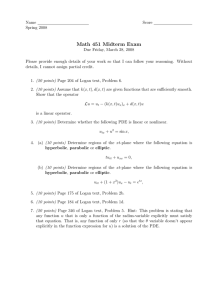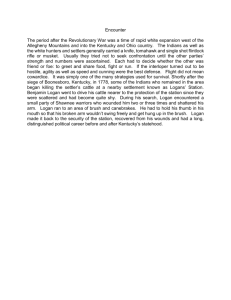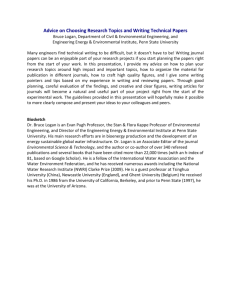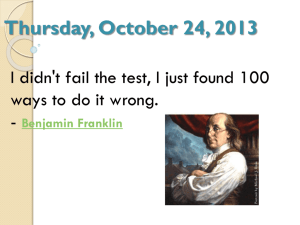USU Community Bridge Initiative Education for the Public Good
advertisement
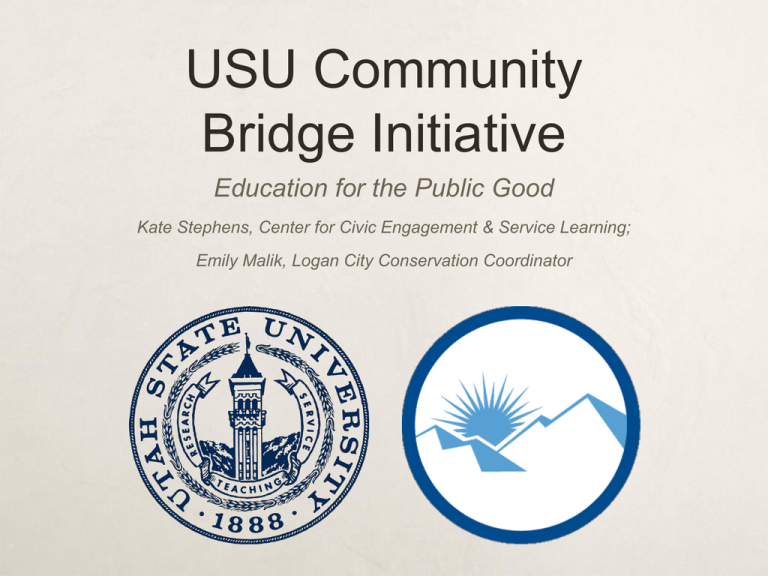
USU Community Bridge Initiative Education for the Public Good Kate Stephens, Center for Civic Engagement & Service Learning; Emily Malik, Logan City Conservation Coordinator What is CBI? CBI is an intentional, placebased approach to ServiceLearning that enables students to utilize knowledge obtained in the classroom to tackle realworld problems identified by the community. Courses are matched with community projects that have been identified by Logan City as high priority. Win-Win Partnership Cities often lack the funds and capacity to implement innovative projects. Ideas and human capacity abound in universities. College students have professional-level training and a need for practical work. CBI brings these two entities together in an exciting interdisciplinary partnership. A Vision for the Future CBI is much more than technical assistance; it is direct engagement, knowledge transfer, and visioning. The model combines faculty expertise with student enthusiasm to offer the community a vision for the future. Dr. Courtney Flint, Sociology Associate Professor Background The CBI model is loosely based on the University of Oregon’s nationally recognized Sustainable City Year Program (SCYP). In April 2014, a team from Logan attended the University of Oregon’s SCYP annual conference to learn more about how this model might be applied to our university and community. The SCYP Model A one-year partnership between the U of O and a City or County Coursework spans multiple departments Fee-for-Service The CBI Model Like SCYP, CBI offers a multidisciplinary approach to tackling community identified projects. Logan is somewhat geographically isolated and many students have employment and family commitments - not feasible for USU students to travel outside of Cache Valley on a regular basis. We wanted CBI to bridge the University-Community divide, and strengthen communication and establish greater reciprocity. CBI is a long-term commitment to a single community (Logan) rather than one-year commitments to multiple communities. How does it Work? CBI matches a multidisciplinary set of courses to a community identified set of projects. Process – Logan City employees submitted project proposals to the mayor’s office. The top 10 projects were selected and USU matched them with faculty and courses. Students and faculty work with community leaders to define meaningful solutions, develop action plans and implement projects directly relevant to their course curriculum. Results As a result…students are given greater depth to their course content and come away with the experience of addressing locally relevant issues, and… Cities gain the knowledge and inspiration needed to transform their communities. 2015 Pilot Year This spring, 7 classes are working on 4 projects. This fall, we plan to have at least 10 classes working on 6 more City identified projects. A community survey is being conducted by an ENVS graduate student, and the results will be used to inform the City as they identify and prioritize projects. The survey results will give project selection greater validity. Graduate student is also surveying students and faculty participating in the first pilot semester and will utilize these results to make program recommendations. Benefits to Logan City Thousands of hours of work from students - increased capacity Cutting edge ideas - a fresh look at projects with a lot of energy behind it. The program adds breadth to the project - several disciplines may look at a project for a unique outcome An opportunity to test the water and look at riskier solutions Increased energy (Internally and as External Engagement) Good Press Re-trains staff Progression of ideas we’ll be using for years to come Air Quality: A CBI Pilot Roslynn Brain: Assistant Professor in Sustainable Communities – College of Natural Resources. Randy Martin: Research Associate Professor – College of Engineering Courtney Flint: Associate Professor – College of Humanities & Social Sciences Edwin Stafford: Associate Professor – Huntsman School of Business Emily Malik: Conservation Coordinator - Logan City Environmental Department OBJECTIVE: PRIZES: DEVELOP AN EDUCATIONAL PUBLIC SERVICE ANNOUNCEMENT POSTER ON HOW PEOPLE IN THE COMMUNITY MAY CONTRIBUTE TO KEEPING CACHE VALLEY’S AIR HEALTHY, ESPECIALLY DURING THE WINTER INVERSION MONTHS. LOGAN HIGH STUDENTS WILL BE MENTORED BY ED STAFFORD AND USU STUDENTS TO HELP DEVELOP HIGH QUALITY AND IMAGINATIVE POSTERS. THERE WILL BE ONE GRAND PRIZE FROM LOGAN CITY OF $100, WITH SEVERAL OTHER “SECOND” PRIZES INVOLVING $50 GIFT CARDS AND OTHER EQUIVALENT AWARDS DONATED FROM LOCAL BUSINESSES. WINNING POSTERS WILL BE RECOGNIZED AT A CEREMONY AT LOGAN HIGH SCHOOL SOMETIME IN EARLY APRIL, AND THEY WILL BE REPRINTED AND DISPLAYED THROUGHOUT THE COMMUNITY IN LOCAL CITY BUILDINGS AND BUSINESSES TO EDUCATE THE PUBLIC ABOUT CLEAN AIR IN TIME FOR EARTH DAY, APRIL 22, 2015. RULES: STUDENTS CAN WORK INDIVIDUALLY OR IN TEAMS (OF TWO OR THREE) AND SUBMIT AS MANY POSTER ENTRIES AS THEIR IMAGINATIONS WILL ALLOW. ENTRIES ARE DUE: MARCH 27th 2015 TIMELINE: TURN YOUR POSTER IDEAS IN TO YOUR TEACHER OR CLUB ADVISOR LATE JANUARY: ED STAFFORD WILL INITIATE THE CONTEST BY GIVING HIS PRESENTATION , “SELLING CLEAN AIR,” TO VARIOUS INTERESTED CLASSES OR CLUBS TO INSTRUCT STUDENTS ABOUT “GREEN MARKETING” AND “MESSAGE FRAMING” TO DEVELOP PROVOCATIVE, MOTIVATIONAL MESSAGES. STUDENTS WILL BE GIVEN A HANDOUT BY ED STAFFORD ON SAVVY MARKETING MESSAGING AND ON LOGAN CITY ’S SPECIFIC OBJECTIVES (E.G., ANTI-IDLING) AND OTHER CLEAN AIR TIPS/IDEAS THAT THEY CAN USE TO DEVELOP THEIR POSTER MESSAGES AND VISUALS . FEBRUARY/MARCH: ED STAFFORD AND ROS BRAIN’S STUDENTS WILL OFFER ONGOING MENTORING OF THE STUDENTS AS THEY DEVELOP THEIR SLOGAN IDEAS AND VISUALS (OVER 6 TO 8 WEEKS). EARLY APRIL: JUDGES INCLUDING LOGAN CITY OFFICIALS, THE MAYOR, ROS BRAIN AND HER STUDENTS, ED STAFFORD AND OTHER COMMUNITY MEMBERS FROM THE CACHE CLEAN AIR CONSORTIUM WILL SELECT THE BEST ENTRIES , AND A CEREMONY WILL BE HELD AT LOGAN HIGH TO ANNOUNCE THE WINNERS. THE HERALD JOURNAL, UTAH PUBLIC RADIO, OTHER MEDIA, AND LOCAL BUSINESS AND COMMUNITY MEMBERS WILL BE INVITED WHERE ALL THE POSTERS WILL BE DISPLAYED AT THE CEREMONY . APRIL 22 (EARTH DAY): REPRINTS OF THE WINNING POSTERS (100 TO 200 POSTERS) WILL BE DISTRIBUTED THROUGHOUT LOGAN CITY FOR DISPLAY IN THE LIBRARY, CITY BUILDINGS, LOCAL BUSINESS WINDOWS AND BULLETIN BOARDS, ETC. ORIGINAL POSTERS WILL REMAIN DISPLAYED AT LOGAN HIGH SCHOOL. QUESTIONS? CONTACT EDWIN STAFFORD ED.STAFFORD@USU.EDU Dr. Randy Martin, Engineering Assoc. Research Professor Dr. Jessica Lucero, Social Work Assistant Professor Want more info? Kate Stephens, Asst. Director USU Center for Civic Engagement & Service-Learning kate.stephens@usu.edu Emily Malik Logan City Conservation Coordinator emily.malik@loganutah.org
